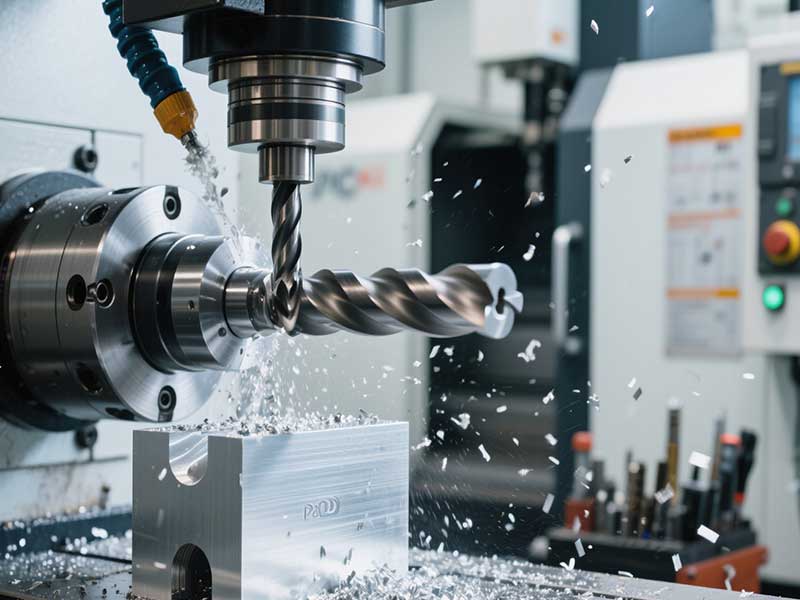In modern manufacturing, aluminum alloys are widely used in aerospace, automotive manufacturing, and the 3C electronics industry due to their lightweight and high strength characteristics. However, traditional carbide milling cutters tend to experience issues like sticking, burrs, and rapid wear when high-speed milling aluminum alloy. PCD milling cutters (Polycrystalline Diamond milling cutters) have emerged as the ideal solution for efficient aluminum alloy processing due to their extraordinary hardness (second only to natural diamond) and extremely low friction coefficient.
PCD (Polycrystalline Diamond) material is made by sintering artificial diamond micropowder under high temperature and pressure, with the following core advantages:
Long life span: The service life can be 50-100 times that of carbide milling cutters when processing aluminum alloys.
Extreme smoothness: Achieves mirror effects below Ra 0.1μm.
High-speed cutting capability: Can reach speeds of over 3000m/min.
Strong anti-adhesion: Diamond hardly reacts chemically with aluminum.
For superhard tool distributors, with the soaring demand for large aluminum alloy parts such as new energy vehicle battery trays and aerospace structural components, PCD milling cutters are becoming representatives of high-value-added products.

Carbon fiber reinforced plastics (CFRP) and fiberglass composites are widely used in aerospace, medical devices, and high-end consumer goods due to their high specific strength and corrosion resistance. However, processing these materials presents several challenges:
Anisotropy leading to delamination and burrs
High abrasiveness causing rapid tool wear
Resin softening and adhering to tools
PCD milling cutters have overcome these challenges through the following innovative designs:
Special edge treatment: A 20° large helix angle design reduces the risk of delamination.
Nano-coating technology: Reduces resin adhesion by over 80%.
Multi-tooth dense structure: Improves surface quality while ensuring smooth chip evacuation.
After a helicopter manufacturer adopted JoyJet PCD milling cutters in processing rotor CFRP parts:
Their processing time was reduced from 8 hours to 2.5 hours.
Tool lifespan increased from 15 parts to 120 parts.
Completely eliminated delamination defects, reducing the scrap rate to 0.
For medical companies processing orthopedic CFRP implants, PCD milling cutters ensure cell-level smoothness of cut surfaces, meeting biocompatibility requirements for implants.
To fully utilize the performance of PCD milling cutters, the following key parameters should be matched to specific processing requirements:
| Workpiece Material | Recommended PCD Grain Size | Typical Cutting Parameters |
|---|---|---|
| Aluminum Alloy (Si<12%) | 10-25μm | Vc=2000-3500m/min |
| High-Silicon Aluminum Alloy | 2-10μm | Vc=800-1500m/min |
| CFRP | 6-15μm | Vc=300-800m/min |
Integral PCD milling cutters: Suitable for high-precision processing with runout ≤0.005mm.
Replaceable head design: Reduces usage costs, tool change time<30 seconds.
Variable helix angle design: Suppresses vibration and improves surface quality.
Must use high rigidity tool holders: Recommended HSK63 or heat shrink tool holders.
Cooling strategy: Minimum Quantity Lubrication (MQL) is recommended for aluminum alloys, and dry cutting for CFRP.
Wear monitoring: Replace the tool when flank wear reaches 0.2mm.
For heat treatment companies processing hardened aluminum alloys, JoyJet has developed a unique "diamond + carbide" composite substrate PCD milling cutter. It maintains the sharpness of the cutting edge while enhancing the tool's impact resistance, successfully solving the processing difficulties of aluminum alloys with HRC40 and above.
From the bulk processing of aluminum alloy housings for 5G base stations to the ultra-precise molding of carbon fiber components for artificial satellites, PCD milling cutters are redefining the possibilities of high-efficiency precision processing. Industry data show that adopting optimized PCD milling cutter solutions can reduce comprehensive processing costs by 40%-70%, while improving surface quality levels by 1-2 grades.
As a leader in PCD tool technology, JoyJet offers comprehensive solutions:
Material Innovation: Patented nanocrystalline PCD materials, wear resistance improved by 30%
Customization Services: Supports CAD/CAM full-process collaborative development
Technical Assurance: Equipped with a cutting force online monitoring system
Contact the JoyJet engineering team now to receive free PCD milling cutter trial machining services!